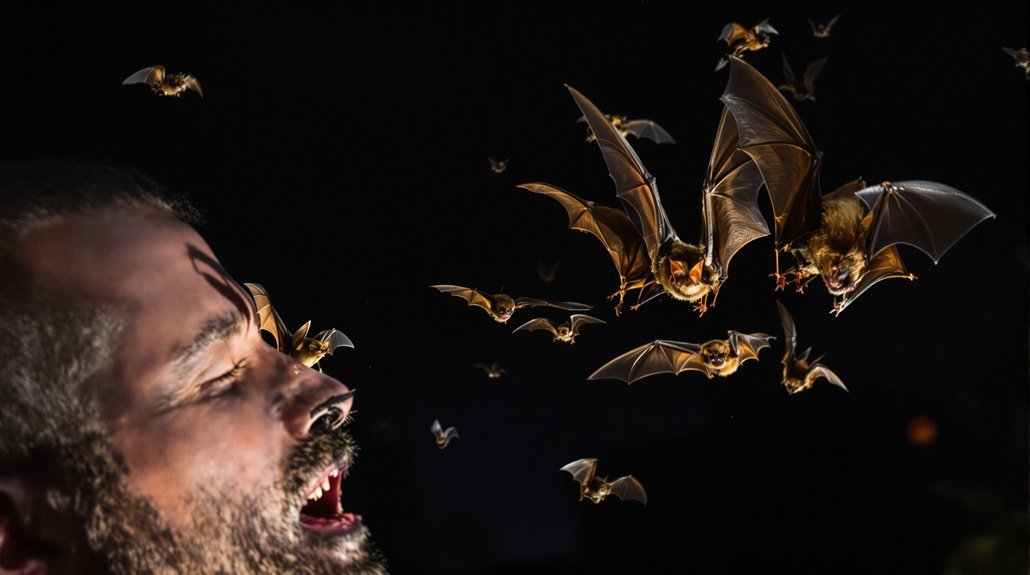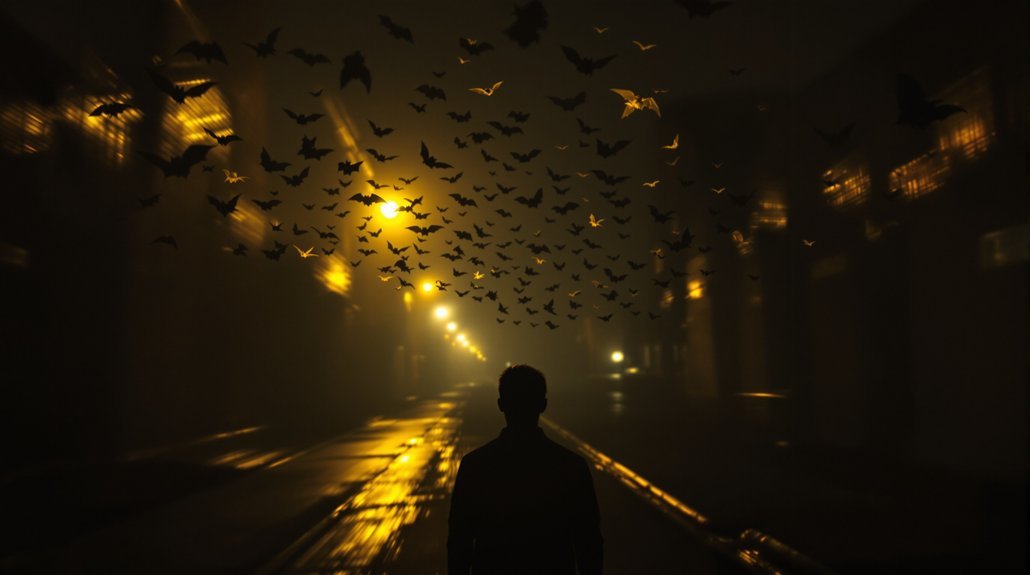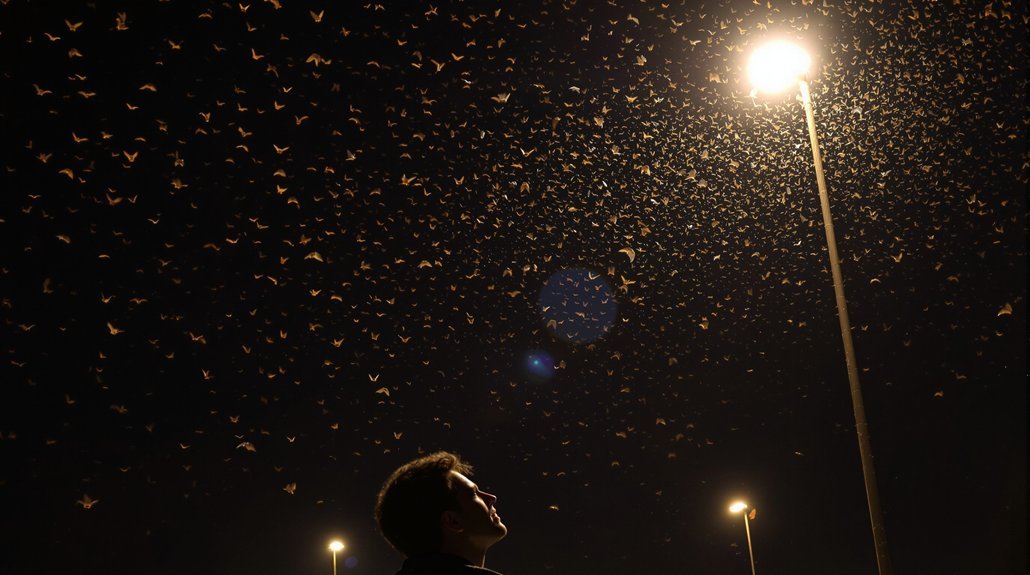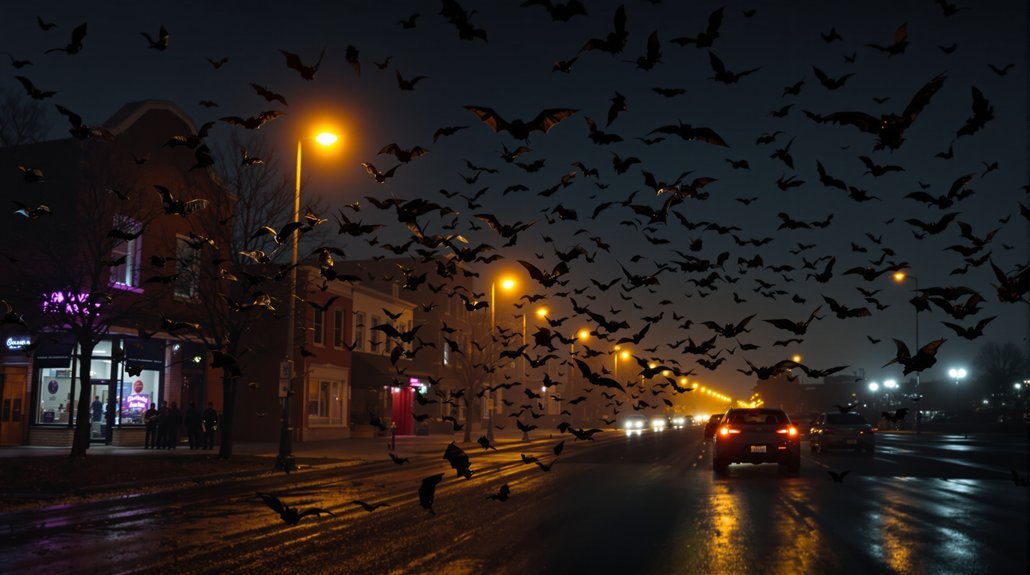Bats fly near people’s heads at night in Des Moines mainly because they are hunting for insects. These insects are often attracted to outdoor lights, bringing bats closer to humans. Bats are not interested in people; they are just focused on catching their prey. Their unique flying skills help them maneuver quickly in tight spaces. Understanding more about bats can help people appreciate their role in urban environments and how to safely coexist with them.
Key Article Highlights
- Bats are attracted to areas with abundant insects, often found near outdoor lights in Des Moines.
- Their flight patterns may bring them close to humans while hunting for insects at night.
- Bats navigate using echolocation, allowing them to fly accurately in the dark, sometimes near head height.
- They may be investigating potential roosting sites or navigating through urban spaces, leading to close encounters.
- Bats are generally harmless, playing a crucial role in controlling pest populations and maintaining urban ecosystem balance.
The Anatomy of Bats and Their Flight Patterns

While many people may find bats unsettling as they swoop through the night sky, understanding their anatomy can shed light on their unique flight patterns. Bat wing morphology is key to their amazing ability to fly. Their wings are made of a thin membrane stretched over elongated fingers. This design allows for flexible movement, making it easier for bats to navigate tight spaces. Their nocturnal flight behavior is fascinating too. Bats can change direction quickly and fly at various speeds, which helps them catch insects or avoid obstacles. This combination of wing structure and flight skills makes bats expert fliers. Their ability to follow air currents between connected spaces aids in their navigation, which is an important aspect of their flight behavior. Learning about these features helps people appreciate the important role bats play in the ecosystem, even if their nighttime antics can be surprising. Additionally, their specialized wing structure allows for precise maneuvering, enabling them to hunt efficiently in the dark.
Echolocation: How Bats Navigate at Night

Bats use echolocation to find their way and hunt for food in the dark. They send out sound waves that bounce off objects, helping them understand their surroundings. This skill lets them navigate and catch insects with ease, even at night.
Sound Waves Utilization
Although maneuvering in the dark can be challenging for many animals, bats have a remarkable ability to find their way using sound waves. This skill is known as bat sonar. Bats emit high-frequency sounds that bounce off objects in their environment. By listening to the returning echoes, they can determine the size, shape, and distance of obstacles. This process is called sound localization. It allows bats to fly swiftly and accurately, even in complete darkness. Their unique ability helps them avoid collisions and navigate through tight spaces. This is why they might seem like they are flying right at your head; they are using their echolocation to explore their surroundings without any fear.
Navigation and Hunting Techniques
When it comes to maneuvering the night, bats rely heavily on echolocation, a fascinating technique that allows them to hunt and avoid obstacles. This method involves emitting high-frequency sound waves that bounce off objects, helping bats create a mental map of their surroundings. With their unique bat architecture, including specialized ears and vocal cords, they can pinpoint prey even in complete darkness. During nocturnal migration, echolocation becomes vital for navigation, allowing bats to travel long distances while avoiding trees and buildings. This skill not only aids in hunting insects but also enhances their ability to find safe roosts. Ultimately, echolocation is essential for bats, making them the skilled navigators of the night sky.
Hunting Techniques: Why Bats Target Insects

Bats are skilled hunters that use echolocation to find insects in the dark. This special ability helps them track down their food as they fly around at night. Their nighttime feeding habits make them efficient at catching bugs, which is why they often zip near people’s heads.
Echolocation for Insect Detection
While flying through the night sky, these fascinating creatures use a remarkable technique called echolocation to find their food. Bat echolocation involves emitting high-frequency sounds that bounce off objects in their environment. This allows bats to “see” their surroundings in complete darkness. When searching for insects, bats send out these sound waves and listen for the echoes that return. The timing and pitch of the echoes give bats important information about the size, distance, and even the shape of their prey. This skill is vital for effective insect detection, helping bats swoop in quickly to catch their meals. Their incredible ability to navigate and hunt in the dark makes them expert nighttime predators.
Nighttime Feeding Habits
Although many creatures are active at night, bats have developed unique feeding habits that focus primarily on insects. These habits are closely linked with their migratory patterns, as bats often travel to areas where insects are plentiful. They use echolocation to locate prey, swooping down to catch insects mid-flight. Their roosting behaviors also play a crucial role; bats often rest in caves or trees during the day before heading out at dusk. This timing allows them to take advantage of nighttime insect activity. By targeting insects, bats help control pest populations, making them important to the ecosystem. Their specialized feeding strategies demonstrate a fascinating adaptation to the night environment, showcasing their role as efficient nocturnal hunters.
The Role of Bats in Urban Ecosystems
What makes bats such important players in urban ecosystems? Bats contribute markedly to the balance of city life. Their nocturnal activity allows them to control pest populations, which can benefit humans. Here are a few key roles bats play:
- Insect control: They eat thousands of insects each night.
- Pollination: Some species help pollinate plants, including fruits.
- Seed dispersal: Bats spread seeds, helping plant diversity.
- Bat migration: They travel for food, connecting different habitats.
- Ecosystem balance: Their presence supports other wildlife.
Common Bat Species in Des Moines
Bats are not only important for urban ecosystems, but they also come in various species that inhabit areas like Des Moines. Among the common species are the little brown bat and the big brown bat. These bats have unique bat wing morphology, which allows for agile flying and quick maneuvers. Their wings are long and narrow, perfect for Flying through tight spaces. Additionally, these bats rely on their excellent nocturnal vision to hunt insects at night. With their keen eyesight and echolocation, they can find food in the dark. Understanding these species helps people appreciate their role and behavior in the city. Bats in Des Moines contribute to a balanced ecosystem while showcasing fascinating adaptations.
Myths and Misconceptions About Bats
Many people hold misconceptions about bats that can lead to fear and misunderstanding. These myths can often be traced back to bat folklore, causing people to view them negatively. Here are some common misconceptions:
- Bats are blind: In reality, bats have good eyesight and use echolocation.
- Bats attack humans: They typically avoid people and bite only when threatened.
- All bats carry rabies: Only a small percentage of bats are infected with this virus.
- Bats are pests: They help control insect populations and pollinate plants.
- Bats are dirty: They maintain clean habitats and groom themselves regularly.
Myth busting these ideas can help people appreciate bats for their ecological importance rather than fear them. Understanding the truth is key to fostering a positive view of these fascinating creatures.
Safety Tips for Bat Encounters
When encountering bats at night, it’s important to know how to stay safe. First, avoid panicking. Bats usually don’t want to interact with people. Remember, bat mythology often exaggerates their danger. If a bat flies near, stay still and let it pass. Do not try to swat or catch it, as this can lead to bites or scratches. Urban myths suggest that bats are aggressive, but most are harmless. If a bat seems to be circling you, calmly walk away from open areas. If you feel threatened, seek shelter indoors. Always make sure your home is bat-proofed to avoid unwanted encounters. Understanding these tips can help dispel fears and ensure a safe experience while enjoying the night sky.
The Importance of Bat Conservation
Although often overlooked, bat conservation plays a indispensable role in maintaining healthy ecosystems. Bats provide essential services that benefit both nature and humans. By focusing on bat conservation, communities can:
- Help control insect populations
- Support pollination of plants
- Protect bat mythology and cultural significance
- Maintain urban roosts as safe habitats
- Promote biodiversity in local ecosystems
These flying mammals are critical for sustainable environments. Their contributions include pest control, which reduces the need for pesticides. Additionally, urban roosts provide safe homes for bats while helping educate the public about their importance. Understanding and supporting bat conservation efforts can lead to healthier ecosystems, showcasing the need for awareness and action regarding these often-misunderstood creatures.
How to Enjoy Bats Without Fear
Enjoying bats can be a rewarding experience, especially for those who appreciate nature’s wonders. To enjoy these fascinating creatures without fear, one should learn about their nocturnal behavior. Understanding that bats are usually more interested in insects than people can ease concerns. Observing them from a distance allows one to appreciate their unique bat wings and graceful flight. Setting up a bat house in the yard can also invite these helpful animals, as they control pest populations. Using soft lighting outdoors can attract insects, creating an ideal setting for bat watching. With knowledge and a little patience, anyone can enjoy the beauty of bats while feeling safe and secure. These small mammals truly add magic to nighttime scenes.

